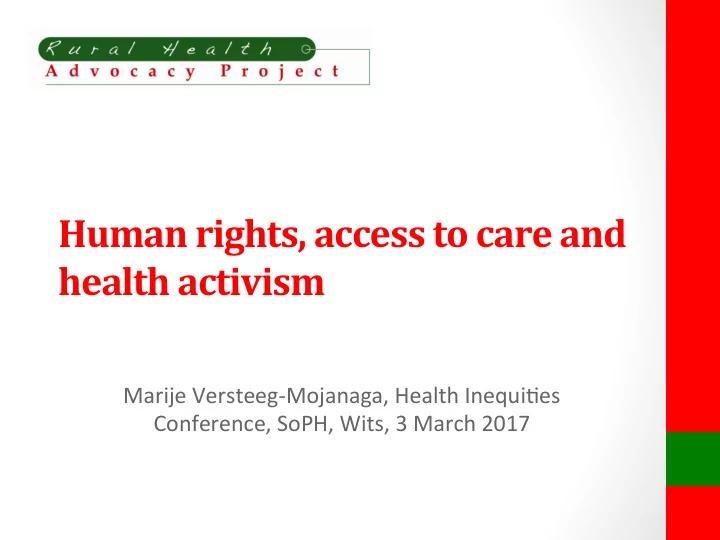

Human rights, access to care and health activism Marije Versteeg-Mojanaga, Health Inequi6es Conference, SoPH, Wits, 3 March 2017
Priority-setting in health care • Health 2017 • Budget constraints • Progressive realisa6on of access to healthcare within available resources
DECREASING STAFF ESTABLISHMENT 2015/04 2017/01 TOTAL FILLED POSTS 18710 17411 -1299 VARIANCE Number of filled posts are decreasing year on year
Four Propositions • Our priority-seJng process in alloca6ng “available resources” is flawed and deepens exis6ng inequi6es • Ethics aside; to cut services to most vulnerable is inefficient • The argument of “(un)available resources” does not hold • Mul6-stakeholder ac6vism needed more than ever
Guidance for Priority-SeJng in Health Care (WHO GPS-Health; Norheim et al, 2014) • Priority-se*ng in achieving health system goals: • Maximising health outcomes through cost-efficiencies (u:lisa:on rates and economies of scale); • Reducing inequi:es; • Minimising financial burden on pa:ents • Group 1: Criteria related to disease and interven:on criteria • Eg: Severity of illness / Past health loss / chronic disability / realisa6on of poten6al • Group 2: Criteria related to characteris:cs of social group s • Eg: Areas of living / socio-economic status / race • Group 3: Criteria related to protec:on against financial and social effects of ill health • Economic ac6vity / care for others / catastrophic health expenditures
1: Priority-setting is 6lawed • Theory versus Prac6ce • Prac6ce favours Maximising health outcomes through cost-efficiencies • Na6onal health outcomes • Economies of scale // small facili6es • Organograms based on u6lisa6on rates • Most vulnerable suffer dispropor6onally
Proportionality and Decision-Making • Freezing 1 nurse post in a small clinic (1) of two nurses serving a farming in the northern part of Dr RSM, serving a small popula6on. The nearest alterna6ve clinic is 40 kms away. • Freezing 1 nurse post in a Zeerust clinic (2) of 4 nurses, serving a large popula6on. The nearest alterna6ve clinic is 8 kms away. • Based on u6lisa6on rates, one might decide to freeze the post in clinic 1 • Based on access and equity, one would priori6ze clinic 2
What does it look like?
Entrenching structural inequity
Who are affected? Mrs Tonyani, Philasanda and family, OR Tambo District, Nov 2016
Canzibe Hospital • Catchment: 100 000 people • Beds: 120 • Doctors: 3 • Rehab professionals: 0 • Nurse shortage • Clinic outreach terminated
2: Cutting Services Inef6icient • Calvinia Hospital, Northern Cape • Obstetrics Unit Closure – 400 KM nearest alterna6ve unit • Children with birth defects • Life long health care • Disability grant • Loss income > state dependency • Legal implica6ons of health care failures by the State • Inefficiencies offset by lack of pa6ent advocacy/ rehab posts freeze/ limited reach social movements • We need more research to document cost to pa6ent, society, the state
3: Unavailable resources: says who?
“Severity Argument”. A clear case: “Maternal and Child services are severely affected, there are not enough nurses, no midwives, and you will find 1 midwife on night duty. It goes against protocol because pa@ents cannot be monitored regularly correctly. This results in maternal deaths”. (NW HCW, 2015)
Constitutional obligations and human rights “Unavailable resources?” Population health vs individual rights? li living ng ali live www.ruresa.org.za
3: Unavailable resources: says who? • Priori6es and trade – offs • Legal and policyframework, PAJA • Fair process; allow key stakeholders to agree on what is legi6mate and what is fair • Vic6ms of health care failures? • The state to explain its priority-seJng processes explicity • Criteria for filling vacant posts • To counter: frozen posts in most deprived districts in areas with no alterna6ves and high personal costs in accessing care Ref: Guidance for Priority-SeJng in Health Care (Norheim 2014)
4: Multi-sectoral activism • Consensus on these points to build mul6-stakeholder health ac6vism from grassroots, to academics and social movements • Equity in budget alloca6ons (ESF, Provincial Government, within provincial DoH) • Enforcement of principles of promo6on of administra6ve jus6ce • Calling government to account for its decisions; explaining to communi6es how it came to its decisions and what principles it applied • Research on cost of healthcare neglect, frozen posts, failure to invest (eg roll-out ini6a6ves such as CHW)
Thank you RURAL HEALTH ADVOCACY PROJECT Marije Versteeg-Mojanaga • Email: Marije@rhap.org.za • Web: www.rhap.org.za • Cell: 074 – 1063800 • Twioer: RHAPnews • Facebook: Rural Health Advocacy Project
Recommend
More recommend